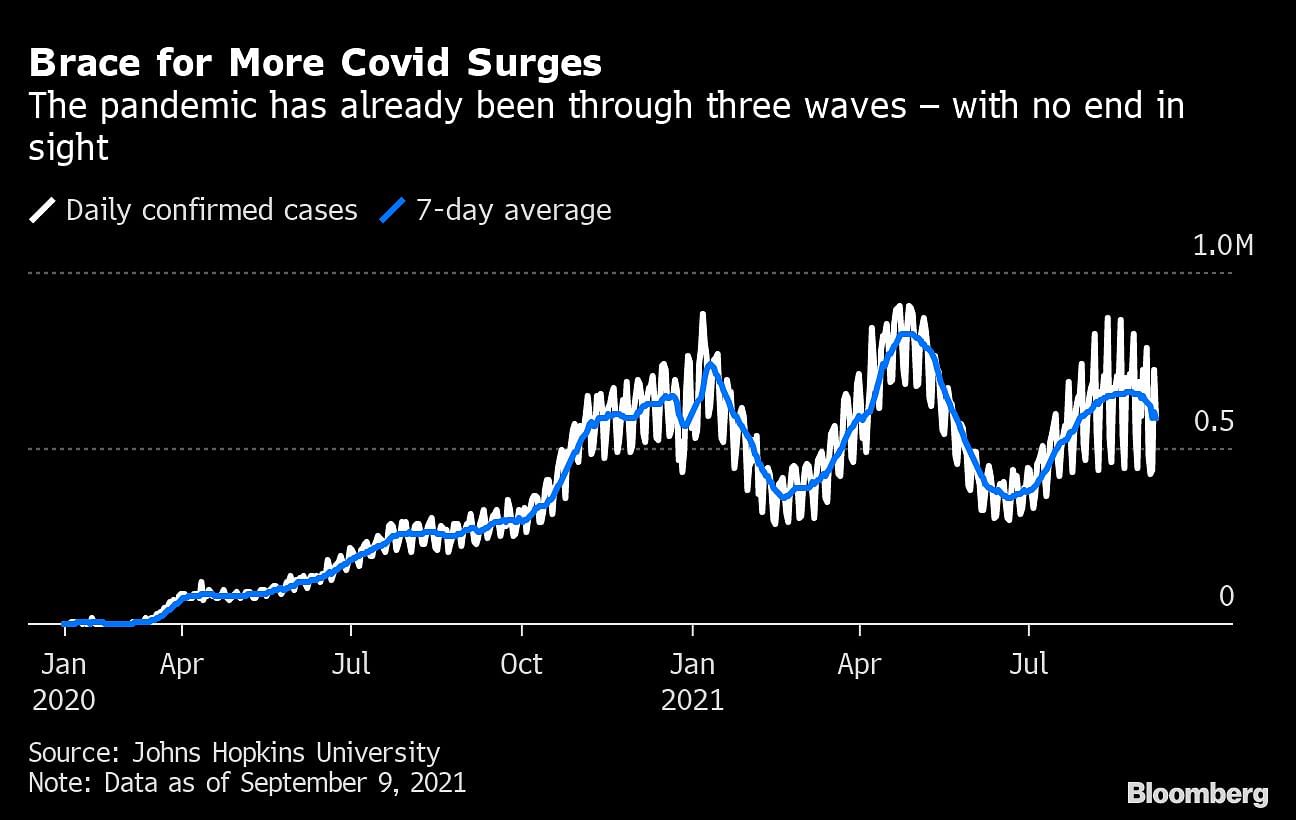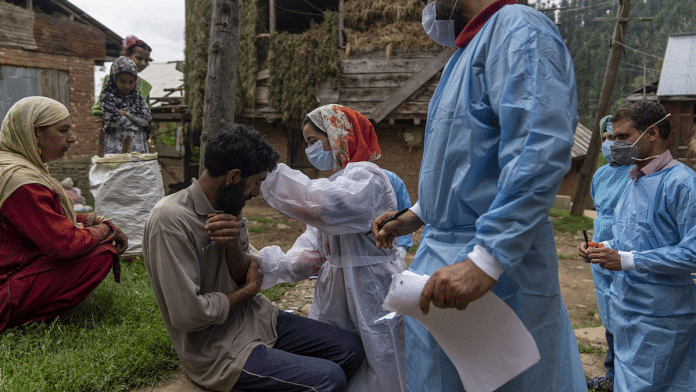Minneapolis: For anyone hoping to see light at the end of the Covid-19 tunnel over the next three to six months, scientists have some bad news: Brace for more of what we’ve already been through.
Outbreaks will close schools and cancel classes. Vaccinated nursing home residents will face renewed fears of infection. Workers will weigh the danger of returning to the office as hospitals are overwhelmed, once again.
Almost everyone will be either infected or vaccinated before the pandemic ends, experts agree. Maybe both. An unlucky few will contract the virus more than once. The race between the waves of transmission that lead to new variants and the battle to get the globe inoculated won’t be over until the coronavirus has touched all of us.
Listen to this story
“I see these continued surges occurring throughout the world,” said Michael Osterholm, director of the Center for Infectious Disease Research and Policy at the University of Minnesota in Minneapolis, and an adviser to U.S. President Joe Biden. “Then it will drop, potentially somewhat precipitously,” he said. “And then I think we very easily could see another surge in the fall and winter” of this year, he added.
With billions of people around the world yet to be vaccinated and little chance now of eliminating the virus, we can expect more outbreaks in classrooms, on public transport and in workplaces over the coming months, as economies push ahead with reopening. Even as immunization rates rise, there will always be people who are vulnerable to the virus: Newborn babies, people who can’t or won’t get inoculated, and those who get vaccinated but suffer breakthrough infections as their protection levels ebb.
The next few months will be rough. One key danger is if a vaccine-resistant variant develops, although it is not the only risk ahead. In the coming months, Bloomberg will explore the pandemic’s long-term impact on economies and markets, the pharmaceutical industry, travel and more.“We’re going to see hills and valleys, at least for the next several years as we get more vaccine out. That’s going to help. But the challenge is going to be: How big will the hills and valleys be, in terms of their distance?” Osterholm said. “We don’t know. But I can just tell you, this is a coronavirus forest fire that will not stop until it finds all the human wood that it can burn.”
The five well-documented influenza pandemics of the past 130 years offer some blueprint for how Covid might play out, according to Lone Simonsen, an epidemiologist and professor of population health sciences at Roskilde University in Denmark. She is an expert on the ebb and flow of such events.
While the longest global flu outbreak lasted five years, they mostly consisted of two to four waves of infection over an average of two or three years, she said. Covid is already shaping up to be among the more severe pandemics, as its second year concludes with the world in the middle of a third wave — and no end in sight.
It’s possible that the virus known as SARS-CoV-2 won’t follow the path set by the pandemics of the past. After all, it is a different, novel and potentially more transmissible pathogen. And with a death toll of more than 4.6 million people so far, it’s already more than twice as deadly as any outbreak since the 1918 Spanish flu. Despite brutal initial waves and relatively high vaccination rates, countries including the U.S., U.K., Russia and Israel are flirting with record numbers of cases. Immunization is helping to moderate incidences of severe cases and deaths, but surging infections mean the virus is reaching the young and others who remain unvaccinated, leading to rising rates of serious disease in those groups.
Nations where vaccination has been sparse — including Malaysia, Mexico, Iran and Australia — are in the midst of their biggest outbreaks yet, fueled by the contagious delta strain. With the virus still spreading out of control in vast swathes of the planet, another novel variant could quite feasibly emerge.
History shows the commonly held belief that viruses automatically get milder over time — to avoid completely wiping out their host population — is wrong, according to Simonsen. Although new mutations aren’t always more severe than their predecessors, “pandemics can in fact get more deadly during the pandemic period, as the virus is adapting to its new host,” she said.
Early in the Covid outbreak, there was good reason to hope that vaccines would provide long-term protection, much like childhood shots that stop diseases such as polio.
Coronaviruses have a “proof-reading” mechanism that fixes the in-born errors caused when the virus replicates, reducing the likelihood of variants emerging when the virus is transmitted from one person to another.
The number of global cases has been so vast, however, that mutations are occurring anyway.
“With the pandemic, we have this enormous force of infection,” said Kanta Subbarao, director of the WHO Collaborating Center for Reference and Research on Influenza at the Peter Doherty Institute for Infection and Immunity in Melbourne. “That has counterbalanced the ability of the virus to proof-read.”
As a result, Covid could be like the flu, requiring regular vaccine top-ups to remain effective as the virus evolves.
Some researchers say SARS-CoV-2 is poised to become completely resistant to the first generation of vaccines. A study from Japan, which has yet to be published or peer-reviewed, suggests that potentially dangerous mutations in the delta variant are already being picked up in a global database used to track such developments. Reports of current strains breaking through vaccinations or triggering higher fatality rates have not held up to rigorous scrutiny thus far. “This is a scenario we hope won’t happen,” Simonsen said. “My God, we would have to do it all again.”
Other even grimmer possibilities for the coming months include the emergence of a novel influenza virus or another coronavirus making the leap from animals into humans.
“As long as there are animal reservoirs of coronavirus there is still the possibility that another zoonotic coronavirus could emerge in the future,” Subbarao said. “There is that in the background, the risk of still dealing with this one when another one emerges.”
Also read: Mu — the latest SARS-CoV-2 ‘variant of interest’ first found in Colombia
What seems clear is that the pandemic will not be over in six months. Experts generally agree that the current outbreak will be tamed once most people — perhaps 90% to 95% of the global population — have a degree of immunity thanks to immunization or previous infection.
The key element should be vaccination, they say.
“Without vaccination, one is like a sitting duck, because the virus will spread widely and find most everybody this autumn and winter,” said Simonsen. More than 5.66 billion doses of vaccine have been administered around the world, according to Bloomberg’s vaccine tracker. But the success of rollouts in some regions, such as the European Union, North America and China, masks the failure in others. Most countries in Africa have only given enough vaccine to cover less than 5% of their populations with a two-dose shot. India has administered enough to cover only about 26%.
The pandemic will end at different times in different places, just as previous outbreaks have, said Erica Charters, associate professor of the history of medicine at Oxford University and the coordinator of a project on how epidemics end. Governments will have to decide how much of the disease they are comfortable living with, she said.
Approaches vary. While some countries are still shooting for zero Covid cases, the world is unlikely to eradicate the virus completely.
Nations like Denmark and Singapore, which have managed to keep cases relatively contained, are already moving toward a post-pandemic future with fewer safety restrictions. Others, such as the U.S. and U.K., are opening up even as infection numbers near records. Meanwhile, China, Hong Kong and New Zealand have vowed to keep vigilantly working to eliminate the virus locally. As a result, they are likely to be among the last places to leave behind the disruption wrought by walling out the pandemic. “The end process is not going to be uniform,” Charters said. The pandemic “is a biological phenomenon, but it’s also a political and social phenomenon.”
“Even now we have different approaches to it.”
It’s likely to be messy, leaving a lasting legacy for years to come. Until then, most of us will need to brace for many more months in the pandemic’s grip.
“We have to approach it with our eyes wide open and with a great deal of humility,” Osterholm said. “Anybody that thinks we’re going to be over this in the next few days or a few months is sorely mistaken.”– Bloomberg
Covid compared to other pandemics

How will Covid end?
Also read: Why the world may never reach herd immunity against Covid-19






